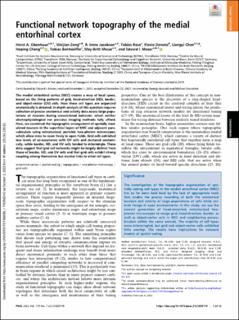| dc.contributor.author | Obenhaus, Horst-Andreas | |
| dc.contributor.author | Zong, Weijian | |
| dc.contributor.author | Jacobsen, R. Irene | |
| dc.contributor.author | Rose, Tobias | |
| dc.contributor.author | Donato, Flavio | |
| dc.contributor.author | Chen, Liangyi | |
| dc.contributor.author | Cheng, Heping | |
| dc.contributor.author | Bonhoeffer, Tobias | |
| dc.contributor.author | Moser, May-Britt | |
| dc.contributor.author | Moser, Edvard Ingjald | |
| dc.date.accessioned | 2022-10-03T06:04:18Z | |
| dc.date.available | 2022-10-03T06:04:18Z | |
| dc.date.created | 2022-04-27T12:29:24Z | |
| dc.date.issued | 2022 | |
| dc.identifier.citation | Proceedings of the National Academy of Sciences of the United States of America. 2022, 119 (7), . | en_US |
| dc.identifier.issn | 0027-8424 | |
| dc.identifier.uri | https://hdl.handle.net/11250/3023141 | |
| dc.description.abstract | The medial entorhinal cortex (MEC) creates a map of local space,based on thefiring patterns of grid, head-direction (HD), border,and object-vector (OV) cells. How these cell types are organizedanatomically is debated. In-depth analysis of this question requirescollection of precise anatomical and activity data across large popu-lations of neurons during unrestrained behavior, which neitherelectrophysiological nor previous imaging methods fully afford.Here, we examined the topographic arrangement of spatially mod-ulated neurons in the superficial layers of MEC and adjacent para-subiculum using miniaturized, portable two-photon microscopes,which allow mice to roam freely in openfields. Grid cells exhibitedlow levels of co-occurrence with OV cells and clustered anatomi-cally, while border, HD, and OV cells tended to intermingle. Thesedata suggest that grid cell networks might be largely distinct fromthose of border, HD, and OV cells and that grid cells exhibit strongcoupling among themselves but weaker links to other cell types. | en_US |
| dc.language.iso | eng | en_US |
| dc.publisher | National Academy of Sciences | en_US |
| dc.rights | Navngivelse 4.0 Internasjonal | * |
| dc.rights.uri | http://creativecommons.org/licenses/by/4.0/deed.no | * |
| dc.title | Functional network topography of the medial entorhinal cortex | en_US |
| dc.title.alternative | Functional network topography of the medial entorhinal cortex | en_US |
| dc.type | Journal article | en_US |
| dc.type | Peer reviewed | en_US |
| dc.description.version | publishedVersion | en_US |
| dc.source.pagenumber | 0 | en_US |
| dc.source.volume | 119 | en_US |
| dc.source.journal | Proceedings of the National Academy of Sciences of the United States of America | en_US |
| dc.source.issue | 7 | en_US |
| dc.identifier.doi | 10.1073/pnas.2121655119 | |
| dc.identifier.cristin | 2019456 | |
| cristin.ispublished | true | |
| cristin.fulltext | postprint | |
| cristin.qualitycode | 2 | |

